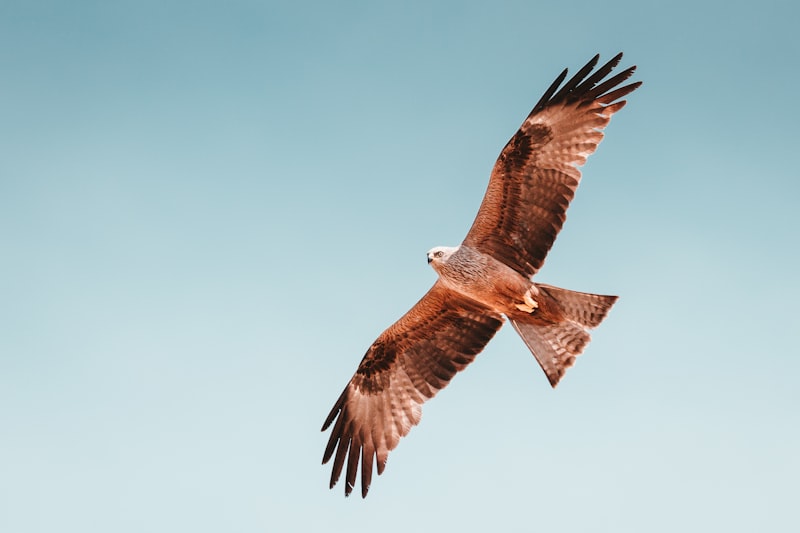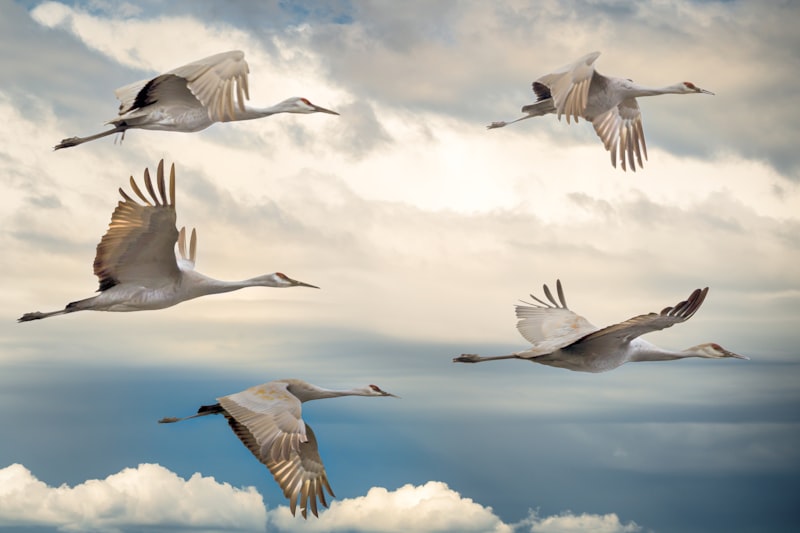Migration is driven by instinct, survival, and the search for better resources. It’s like a grand adventure where animals embark on long, perilous journeys to reach their destinations. Take the Arctic tern, for example, known for flying from the Arctic to the Antarctic and back—a round trip spanning over 40,000 miles! This epic voyage is fueled by the need to find optimal breeding grounds and food sources throughout the year.

But how do they navigate such vast distances? It’s a combination of factors—internal compasses aligned with the Earth’s magnetic fields, landmarks like rivers and mountains, and even celestial cues such as the position of the sun and stars. Imagine having an inbuilt GPS that never needs recharging!

Not all migrations involve flying across continents. Some species, like wildebeests in Africa, undertake mass terrestrial migrations in search of greener pastures and water sources. These migrations not only ensure their survival but also play a crucial role in maintaining ecosystem balance. Predators like lions and hyenas often follow these herds, creating a dynamic cycle of life on the savannah.
Interestingly, migration isn’t limited to birds and mammals. Marine animals like whales and fish also travel vast distances for breeding, feeding, and seasonal changes. The humpback whale, famous for its haunting songs, migrates thousands of miles between cold feeding grounds and warm breeding waters each year.
Animal migration patterns are a testament to nature’s resilience and adaptability. They remind us of the interconnectedness of ecosystems and the importance of conservation efforts to protect these incredible journeys for future generations to marvel at. So, the next time you see a flock of geese flying south for the winter or witness a herd of zebras on the move, remember the awe-inspiring story behind their migration.
Mystery Unveiled: How Animals Navigate Across Continents During Migration
Migration is more than just a seasonal movement for these creatures; it’s a survival strategy honed over millennia. Take the Arctic Tern, for example. This bird travels from its breeding grounds in the Arctic all the way to Antarctica and back, covering a staggering 44,000 miles annually. How does it accomplish such a daunting journey without Google Maps? The answer lies in a remarkable internal compass guided by the Earth’s magnetic field and celestial cues.
Similarly, the Monarch butterfly embarks on an awe-inspiring migration from North America to Mexico, where it clusters in dense colonies in oyamel fir forests. These delicate insects navigate through changing weather patterns and over vast landscapes, relying on a combination of sunlight and an innate sense of direction imprinted in their DNA.
But it’s not just birds and butterflies; large mammals like wildebeests and zebras undertake perilous journeys across the African savannah in search of greener pastures. These herds traverse rivers teeming with crocodiles and vast plains where predators lurk, yet they manage to find their way year after year.
Scientists believe that animals use a variety of cues to navigate during migration, including landmarks, smells, and even the Earth’s magnetic field. Some species, like salmon, rely on their sense of smell to return to their natal streams from the open ocean, where they were born years earlier.
Understanding how animals navigate across continents during migration not only sheds light on their remarkable abilities but also underscores the importance of preserving their habitats. As climate change and human activities continue to alter landscapes, these migration routes face increasing challenges, threatening the survival of many species.
Next time you witness a flock of geese flying overhead in perfect V-formation or marvel at the sight of a whale breaching the surface during its annual migration, remember the incredible journey these animals undertake. It’s a testament to nature’s resilience and the enduring spirit of survival ingrained in every creature on Earth.
The Science Behind Animal Migration: Instinct or Learned Behavior?
Instinct plays a crucial role in animal migration. Many species, such as birds, sea turtles, and certain mammals, exhibit remarkable navigational skills without prior experience or guidance. They seem to possess an inherent ability to sense direction using environmental cues like the sun, stars, Earth’s magnetic field, and even landmarks. This innate sense of direction ensures they can travel thousands of miles accurately, returning to breeding grounds or warmer climates seasonally.
However, the idea of migration as purely instinctual has been challenged by studies showing that some animals can learn and adjust their migratory behavior based on experience. For example, younger birds might follow older individuals or learn from trial and error during their initial migrations. This learning process can enhance their efficiency and survival, helping them navigate obstacles such as weather changes and human development.
The debate over instinct versus learned behavior extends beyond navigation. It includes the timing of migration, which is often synchronized with food availability and environmental conditions. Some researchers argue that while initial migration routes might be instinctual, adjustments and adaptations over generations can be influenced by learning.
Analogously, migration patterns can be compared to human travel habits. Just as people learn to navigate cities they visit frequently or find shortcuts based on experience, animals may refine their migratory routes over time.
Understanding the interplay between instinct and learned behavior in animal migration is vital for conservation efforts and predicting how species might respond to environmental changes. By studying migratory patterns, scientists gain insights into evolutionary adaptations and the resilience of species in a changing world.
From Arctic Tundra to Tropical Rainforests: Exploring Diverse Migration Routes
Imagine the Arctic tern, a bird known for its annual migration from the Arctic to the Antarctic and back—a round trip totaling over 70,000 kilometers. This incredible journey takes it through diverse climates, crossing oceans and continents. It’s a testament to endurance and navigation skills honed over generations.
Similarly, the monarch butterfly travels thousands of miles from North America to central Mexico, where it clusters in dense forests during the winter. These delicate creatures navigate not by map but by a complex interplay of environmental cues and inherited knowledge.
In contrast, the wildebeest of the Serengeti undertake a circular migration driven by the search for fresh grazing pastures. Millions of wildebeest, accompanied by zebras and gazelles, move in synchronized herds, facing predators and crossing crocodile-infested rivers—an annual spectacle of survival against the odds.
Migration isn’t just a survival strategy; it’s also crucial for maintaining ecosystems. Salmon, for instance, swim upstream from oceans to freshwater rivers, where they spawn and die, enriching the nutrient cycle that supports entire food webs.
These journeys aren’t without peril. Climate change, habitat loss, and human activity pose increasing threats to migratory species. The delicate balance that sustains these migrations is under constant pressure.
Understanding these migration routes isn’t merely an academic pursuit; it’s essential for conservation efforts. By protecting key habitats and ensuring connectivity between them, we can safeguard the future of these awe-inspiring journeys that span the globe.
Climate Change’s Impact on Animal Migration: Adapting to a Warming World
Take the Arctic tern, a remarkable bird known for its annual migration from the Arctic to the Antarctic and back—a round trip of over 70,000 kilometers. With rising temperatures altering ocean currents and disrupting fish populations, the tern must navigate longer distances to find food and suitable breeding grounds. This extended journey not only exhausts the birds but also threatens their survival.
Similarly, polar bears, icons of the Arctic, are experiencing habitat loss due to melting sea ice. They rely on ice platforms to hunt seals, their primary food source. As ice melts earlier in the spring and forms later in the fall, polar bears face longer fasting periods, impacting their health and reproductive success. Some bears are venturing inland in search of food, bringing them into conflict with human settlements—an unforeseen consequence of their changing environment.
In Africa, the wildebeest migration across the Serengeti is intricately linked to seasonal rainfall patterns. Climate change is altering these patterns, leading to unpredictable droughts and floods. This instability disrupts the timing of migration, affecting not only wildebeest but also predators like lions and hyenas that depend on this migration for their own survival.
The consequences of disrupted animal migrations are far-reaching. Ecosystems depend on these movements for nutrient cycling, seed dispersal, and predator-prey relationships. As species struggle to adapt or relocate to more hospitable environments, biodiversity is threatened, and delicate ecological balances are at risk of collapse.
Adapting to a warming world requires global efforts to mitigate climate change and protect critical habitats. Conservation initiatives, sustainable resource management, and international cooperation are essential in safeguarding the natural world and ensuring the survival of migratory species facing unprecedented challenges.
Surprising Discoveries: How Technology Helps Track Elusive Migration Routes
Imagine a world where tiny GPS trackers and satellite imagery unveil the hidden paths of creatures like the Arctic tern, known for its astonishing annual journey from pole to pole. These advanced devices, no larger than a coin, now enable scientists to monitor wildlife movements with unprecedented precision. By attaching these trackers to animals, researchers can gather real-time data on their routes, speed, and even environmental conditions encountered along the way.
The insights gained from such technology have shattered old paradigms. For instance, it was once thought that elephants roamed in a haphazard manner. Yet, GPS collars have revealed intricate migration patterns, demonstrating how these majestic beasts navigate across vast landscapes to find water and food sources.
Moreover, drones equipped with thermal imaging and high-resolution cameras have opened new vistas in tracking migratory species. From counting bird populations to spotting endangered species in remote habitats, drones provide a bird’s-eye view that was previously unattainable.
In addition to hardware, sophisticated software algorithms play a pivotal role. Machine learning algorithms analyze vast amounts of tracking data, uncovering trends and anomalies that aid conservation efforts. These insights help formulate targeted conservation strategies to protect critical habitats and migration corridors.
Secrets of the Deep: Unraveling Oceanic Migration Patterns of Marine Species
Marine species, from majestic whales to tiny plankton, undertake incredible journeys across vast expanses of the ocean. These migrations are not just random movements but are intricately linked to the cycles of life and the search for food, breeding grounds, and suitable habitats. Understanding these patterns is crucial for marine biologists and conservationists alike.
One of the most awe-inspiring migrations is that of the humpback whale. These giants of the sea travel thousands of kilometers each year, navigating from their feeding grounds in colder waters to warmer waters where they breed and give birth. It’s a journey that showcases both the strength and determination of these magnificent creatures.
For smaller marine species like sea turtles, migration is equally vital. Take the leatherback sea turtle, for instance. They travel immense distances to lay their eggs on specific beaches where they were born, a journey that spans oceans and continents. This homing instinct is an evolutionary marvel that ensures the survival of their species across generations.
But what drives these incredible migrations? It’s a combination of factors including instinct, environmental cues such as temperature and currents, and the need to find optimal conditions for survival. Each species has adapted uniquely to these challenges, demonstrating nature’s remarkable ability to find solutions to the complexities of life in the ocean.
Migration patterns also play a crucial role in marine ecosystems. For instance, the movement of fish species helps distribute nutrients and energy across different regions of the ocean, influencing everything from plankton populations to larger predators. It’s a delicate balance that underscores the interconnectedness of marine life.
As we uncover more about these oceanic migration patterns, we gain not only scientific insights but also a deeper appreciation for the wonders of the natural world. It’s a reminder that beneath the waves, there is a world of discovery waiting to be explored and understood.
So next time you gaze out at the vast expanse of the ocean, remember that it holds secrets of migration patterns that are as intricate and awe-inspiring as any journey on land.
Frequently Asked Questions
How do scientists study and track animal migration patterns?
Learn how scientists study and track animal migration patterns using techniques such as satellite tracking, radio telemetry, and citizen science initiatives. These methods help gather data on routes, timing, and behaviors crucial for conservation and ecological research.
How do animals navigate during migration?
Learn how animals navigate during migration with this concise FAQ. Discover the fascinating mechanisms behind animal migration, including celestial cues, magnetic fields, and environmental landmarks. Understand how different species use these natural signals to travel vast distances with precision and efficiency.
What factors influence changes in animal migration over time?
Discover the key factors influencing changes in animal migration patterns over time. Learn how environmental shifts, habitat alteration, and climate change impact migratory behavior in diverse species.
What are the different types of animal migration?
Learn about the various types of animal migration, including seasonal, altitudinal, latitudinal, and irregular migrations. Discover how animals navigate vast distances for breeding, feeding, or climate changes.
What are animal migration patterns and why do animals migrate?
Learn about animal migration patterns and the reasons behind them. Discover how different species navigate seasonal movements to find better food sources, suitable breeding grounds, or milder climates. Understand the ecological benefits of migration and how it aids in species survival and biodiversity.


